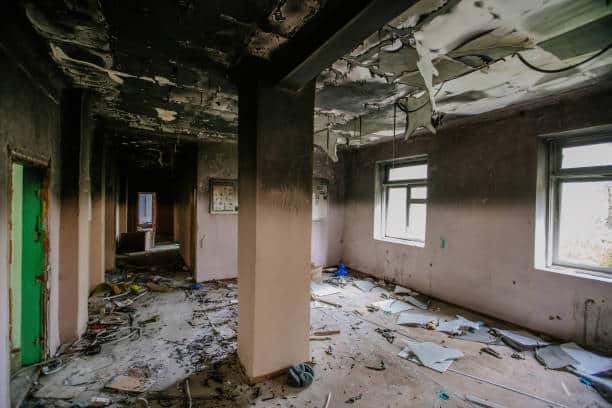You’re grabbing something from the basement when you notice it, dark spots spreading across the lower corner of the wall. Is it dirt? Water stains? Or could it be mold? You’re not alone if you’ve ever squinted at suspicious discoloration in your home.
Mold can present a serious challenge for Allentown residents. Seasonal humidity, older housing, and temperature fluctuations create prime conditions for mold growth. What might look like harmless discoloration today could signal a larger problem that affects your family’s health and your home’s structure tomorrow.
Not all mold looks or behaves the same way. From the common greenish-black growth around windows to the notorious black mold that makes headlines, different types require different approaches. Some are merely unsightly, while others can trigger allergies, respiratory issues, or worse.
Before you grab bleach or call a contractor, you must know precisely what you’re dealing with. We will walk you through visual identification, non-visual warning signs, and testing options to help you determine if that suspicious spot is indeed mold and what type you might be facing.
Visual Identification
Knowing its common disguises can help you spot mold in your Allentown home. Depending on the type and surface on which it grows, mold can come in various colors and textures. While many think mold is always black, it appears in numerous forms.
Common visual characteristics to watch for include:
- Discoloration ranging from white and gray to green, brown, or black
- Fuzzy or slimy textures that may change with age
- Spotty patterns that spread outward from a central point
- Raised growth that might appear powdery or velvety
- Staining that remains even after surface cleaning
Specific locations in Allentown homes practically invite mold growth. Basements top the list, especially where limestone foundation walls meet changing seasons.
The junction between exterior walls and flooring often reveals the first signs of a developing problem. Bathroom ceilings, particularly in older homes with inadequate ventilation, frequently show spotting above shower areas.
Sometimes, close inspection is required to distinguish between mold and ordinary household stains. Water stains typically have more defined edges and don’t change appearance over time.
Dirt generally wipes away easily, while mold tends to smear when disturbed and may leave staining behind. Efflorescence (that whitish mineral deposit on masonry) might look like white mold but lacks the fuzzy texture and wipes away more easily.
The visible mold often represents just the tip of the iceberg. When you spot surface growth larger than a dinner plate, experience shows that hidden growth likely extends much further within walls, under flooring, or above ceilings. Pay special attention to patterns that follow likely moisture paths along baseboards, around windows, or tracking up wall studs.
Non-Visual Signs
That musty smell hitting you when you open the basement door? It’s not just “old house smell”; your nose might detect mold before your eyes do.
Most homeowners don’t realize their bodies often react to mold before they ever see it. Have you noticed any of these warning signs of mold?
- Family members with increased allergy symptoms that mysteriously improve during vacations
- Headaches that seem to appear when spending time in certain rooms
- Kids’ asthma getting worse for no apparent reason
- Itchy eyes or skin rashes that come and go
- Trouble sleeping that improves when staying somewhere else
Even your pets might be trying to tell you something. That spot your dog suddenly refuses to lie down in? Or your cat’s new sneezing fits? Animals often detect and react to mold before humans notice anything wrong.
Pay attention to patterns of moisture throughout your home. Those windows that always fog up, the corner of carpet that never quite feels dry after cleaning, or that one bathroom wall that stays cool to the touch are all potential mold breeding grounds.
DIY Testing vs. Professional Assessment
So you’ve spotted something suspicious or noticed those telltale signs of mold. What next? The testing dilemma often confuses homeowners: Should you grab a kit from the hardware store or call in the pros?
Those DIY mold test kits lining the shelves at local stores promise quick answers but come with significant limitations. Most fall into three main categories:
- Air sampling kits that capture spores for analysis
- Swab tests for visible mold
- Petri dish collectors that grow whatever spores are present
While these might confirm that “yes, you have some type of mold,” they rarely tell you what specific type you’re dealing with or how extensive the problem might be. Think of them as confirming your suspicions rather than providing complete answers.
The biggest drawback? Store-bought kits can’t locate the source of your mold problem. Knowing you have mold doesn’t help much if you can’t find where it’s coming from or how far it’s spread.
While more expensive, professional mold inspections provide crucial information that DIY methods miss. A thorough assessment from an experienced inspector typically includes:
- Moisture mapping throughout your home
- Thermal imaging to detect hidden dampness inside walls
- Air quality sampling from multiple locations
- Surface testing of suspicious areas
- Inspection of HVAC systems and ductwork
The real value comes from their trained eye and experience with hundreds of Allentown homes. A good inspector can spot the patterns and follow moisture to its source, whether it’s a roof leak, foundation issue, or plumbing problem that might not be obvious.
When deciding between DIY and professional assessment, consider what you’ll do with the information. DIY methods might suffice if you want confirmation that the fuzzy stuff in your shower is indeed mold (it almost certainly is).
But if you’re experiencing health symptoms, planning remediation, or dealing with a persistent problem, professional testing provides the detailed roadmap you’ll need to solve the problem permanently.
Take Action Against Mold Today
Finding mold in your home can feel overwhelming, but knowing what you’re dealing with is the crucial first step toward solving the problem. Don’t let uncertainty lead to inaction; mold issues rarely resolve themselves and typically worsen over time.
If you’ve noticed suspicious signs in your Allentown home, Compleat Restorations can help with accurate identification and practical solutions. Our experienced inspectors understand local homes’ challenges and can pinpoint visible and hidden mold problems.
Our thorough assessment process includes:
- Comprehensive visual inspection of problem areas
- Moisture mapping to identify potential sources
- Professional-grade testing when necessary
- Clear explanation of findings in plain language
- Customized remediation recommendations
Even after successful mold removal, we recommend periodic checks of previously affected areas, especially during seasonal changes when moisture levels fluctuate. Our team can show you what to watch for and help you implement preventive measures to keep mold from returning.Contact Compleat Restorations today for a professional mold assessment. Whether you’re dealing with visible growth or suspicious symptoms, our Allentown mold remediation specialists will help you breathe easier, literally and figuratively.


